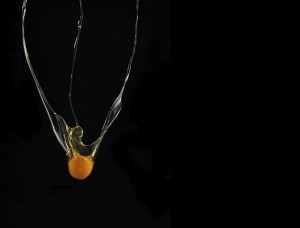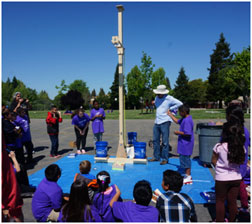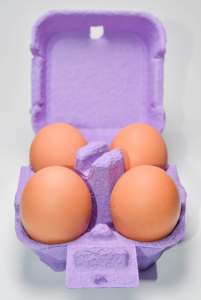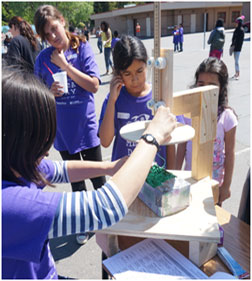Naked Egg Drop
Naked Egg Drop activity contributed by the University of California, Davis’ s College of Engineering. It is one of the activities on TeachEngineering.org, a searchable online library of teacher-tested lessons compiled by the Integrated Teaching and Learning Program, College of Engineering, University of Colorado, Boulder.
Summary
Paris of students in grades 3 to 6 experience the engineering design process by building and modifying devices to catch and protect a “naked” egg as it is dropped from increasing heights. The activity scales up to district or regional egg drop competitions.
Grade level: 3-6
Time: 120 minutes
Learning Objectives
- Explain the transfer of potential to kinetic energy of a dropped egg and explain where the energy goes after it hits the egg catcher.
- Explain why some materials are better than others for absorbing the kinetic energy of a falling egg.
- Describe the relationship between height and the kinetic energy of a dropped egg.
- Explain design modifications made during the design process, weighing factors such as height and materials.
Learning Standards
Next Generation Science Standards
- Define a simple design problem reflecting a need or a want that includes specified criteria for success and constraints on materials, time, or cost. [Grades 3 – 5]
- Generate and compare multiple possible solutions to a problem based on how well each is likely to meet the criteria and constraints of the problem. [Grades 3 – 5]
- Plan and carry out fair tests in which variables are controlled and failure points are considered to identify aspects of a model or prototype that can be improved. [Grades 3 – 5]
- Make observations to provide evidence that energy can be transferred from place to place by sound, light, heat, and electric currents. [Grade 4]
- Apply scientific ideas to design, test, and refine a device that converts energy from one form to another. [Grade 4]
- Define the criteria and constraints of a design problem with sufficient precision to ensure a successful solution, taking into account relevant scientific principles and potential impacts on people and the natural environment that may limit possible solutions. [Grades 6 – 8]
- Evaluate competing design solutions using a systematic process to determine how well they meet the criteria and constraints of the problem. [Grades [6 – 8]
International Technology and Engineering Educators Association
- The engineering design process involves defining a problem, generating ideas, selecting a solution, testing the solution(s), making the item, evaluating it, and presenting the results. [Grades 3 – 5]
- E. Models are used to communicate and test design ideas and processes. [Grades 3 – 5]
- F. Design involves a set of steps, which can be performed in different sequences and repeated as needed. [Grades 6 – 8]
Engineering Connection
Engineers must understand the concepts of energy transfer, conservation of energy, and energy dissipation in order to design real-world projects. They also must understand the properties of materials to design complex systems. Materials can dissipate energy through various means, such as heat, light and vibration. For example, engineers design skyscraper foundations using concrete and steel that can withstand the huge force of the building it supports during earthquakes. Engineers who design computer keyboards want to select a material that can be repeatedly tapped, feels good under finger tips, is inexpensive and environmentally benign, and is cleanable. Identifying the materials that help to meet project constraints is an important aspect of the design process.
Materials List

- 1 or more sheet(s) of paper, to sketch and plan egg catcher designs
- pencils
- scissors
- tape and/or glue; white glue for younger students; hot glue for adult helpers and older students
- at least 1 raw egg (depending on the number of testing trials planned per group)
- computer with Internet access, for the research phase of the engineering design process
- Novice Engineer Pre-Assessment, one per student
- Naked Egg Drop Rules and Score Sheet, one per group
- Expert Engineer Post-Assessment, one per student
- Provide materials such as cardboard or paperboard, clean food containers, foam, tissue paper, fabric, rubber bands, packing peanuts, fiberfill, bubble wrap, cotton balls, grass and other soft and cushiony materials. Reduce the cost by salvaging these materials as much as possible and/or asking students to salvage and bring items from home.
- Do not provide the following materials because they are such excellent shock absorbers (it is nearly impossible to break the egg from amazing heights): food and food ingredients, powders (sand, flour, baby powder), and pastes and gels that stay wet.
Competition supplies to share with the entire class:
Photo: Students keep their eyes on the egg during the naked egg drop competition. Copyright © 2015 Denise Jabusch. Used with permission.
- 6 foot (or taller) ladder

- tape measure
- tarp, newspaper or butcher paper, to simplify clean up
- concrete or asphalt slab on which to hold the egg drop competition since grass absorbs a significant amount of shock
- (optional alternative to the ladder) To improve student safety and increase the wow factor, build an egg dropper rig using the materials list and building instructions provided in the Egg Dropper Construction and Use (see photo). Building the device is especially recommended if a district or regional competition is planned as part of the Elementary School Engineering Design Field Day unit, since its labor and material costs can be shared among many instructors/classrooms/schools. Estimated materials cost for the rig is ~$300.
- (optional) Especially helpful for large competition events, make a tool to enable quick measurements of egg catcher diameters and heights before the egg drop, as a way to easily enforce the design constraints. The homemade device in Figure 6 consists of a 25-cm diameter circle cut out of wood and an arm with a sliding ruler for measuring device height.
- (optional) For the testing/competition, it may be helpful to have a few other adults or older students on hand to serve as judges and helpers to perform material and dimension checks.
Introduction/Motivation
Procedure
Before the Activity
- Decide whether to provide students with an assortment of building materials from which to use, or break the first hour into two parts, with time in between for the teacher and/or students to acquire building materials as specified from group designs. Then, for the building component of the activity, assemble scavenged or purchased materials and/or request that students bring scavenged or purchased materials from home. Take note of the banned list of materials—items that are too effective at being shock absorbers!
- Gather and assemble materials for students to plan and build egg catchers.
- Gather and assemble competition supplies and equipment. Arrange for extra helpers and judges if necessary.
- Make copies of the Novice Engineer Pre-Assessment, Naked Egg Drop Rules and Score Sheet and Expert Engineer Post-Assessment.
With the Students
- Administer the pre-assessment, as described in the Assessment section.
- Present the Introduction/Motivation content to the class.
- Divide the class into groups of two students each. Hand out the supplies, including the rules and score sheet.
- Introduce the design challenge: To create a device to catch an egg dropped from a height without the egg breaking.
- Review the steps of the cyclical and iterative engineering design process. Tell students that as student engineers, they might begin by asking questions to understand the problem, including its criteria and constraints, then researching to learn more, then imagining ideas before making plans for how to create the best solution they can think of. Next, teams each create a prototype, test it, and change and improve the design from what they learn through testing.
- Ask: Identify the need and constraints. Have students read the first page of the competition rules and score sheet. As mentioned earlier, the engineering “need” is to design a device to catch an egg dropped from a height without the egg breaking. Make sure teams are aware of the constraints (requirements and limitations). Remind students that the egg catchers must be made of approved materials (no gels, food, powders), have all materials secured, and be less than 25 cm in any direction.
- Research the Problem. Have student teams independently investigate materials science and energy of motion topics. Show the class the Squash Ball Bounce video and discuss the elasticity measuring device. Additional research might focus on inventions such as trampolines, catchers’ mitts and rock climbing pads to learn about their design approaches and materials.
- Imagine: Develop possible solutions. Direct student teams to brainstorm together and then design and sketch on paper their ideas for egg catcher designs. Remind students to include dimensions and materials lists. Remind them to calculate the surface area available to catch the egg of their planned devices. Encourage students to salvage materials or use materials some people consider waste (what’s in the recycling bin?). Engineers often try to incorporate underutilized materials like “waste” to decrease the cost and the environmental impact of their designs. Examples include saved and dried paper towels used as cushioning in the egg catcher or an empty cereal box to make the egg catcher exterior structure.
- Plan: Select a promising solution. After teams have developed a few design ideas, have them decide on a final design. Remind them to review the rules and scoring sheet to make sure the design addresses and considers all the constraints.
- Require the final plan to include a drawing of what the catcher will look like including labels that describe special features, and a list of materials and amounts, especially if the teacher is providing the materials.
- Create: Build a prototype. Next, student engineering teams each build an initial prototype. Figures 1 and 5 show examples of completed student-designed and -built egg catchers.

- Test and evaluate prototype. A) Use the score sheet to record pre-competition material and dimension checks to verify that team prototypes meet all the constraints, balancing the conflicting factors of their devices. This includes a check for permitted vs. banned materials and a shake test, plus measurement of the catcher height and footprint area (all dimensions must be < 25 cm). B.) Then test the catchers by dropping eggs either by hand from a ladder or by using an egg dropper device (like the one shown above). The minimum drop height is 100 cm and the maximum height for the egg-dropping device is 365 cm. The maximum height using a ladder depends on ladder height and student safety limitations. C.) During competition, give each group three drops; let them pick how much to increase the height between each successful drop. D.) After the test, students calculate their drop height-to-catcher height ratios, which are indicators of effective design and used to determine the competition winner. The shorter the egg catcher and the taller the drop ratio indicates a team that has selected materials and amounts that can successfully dissipate much kinetic energy.
- Improve: Redesign as needed. Expect students to learn a lot from their egg catcher tests and from observing other teams’ tests, resulting in many ideas for design improvement and refinement.
- Regroup the teams or class to discuss what parts of their designs worked well and what needs to be changed during the re-design process. If an egg breaks due to bouncing, a revised design might raise the catcher walls. If an egg breaks due to inadequate cushioning, a team might change the material amount or type. Other issues might be the result of student error, such as poor aiming of the dropped egg or sloppy placement of the catcher on the ground below the egg.
- Then direct teams to restart the design process with their design changes in mind. Test again, as time and materials permit, declaring a winner at competition end.
- Administer the post-assessment, as described in the Assessment section.
Attachments
- Novice Engineer Pre-Assessment (docx)
- Novice Engineer Pre-Assessment (pdf)
- Novice Engineer Pre-Assessment Answer Key (docx)
- Novice Engineer Pre-Assessment Answer Key (pdf)
- Egg Dropper Construction and Use (docx)
- Egg Dropper Construction and Use (pdf)
- Naked Egg Drop Rules and Score Sheet (docx)
- Naked Egg Drop Rules and Score Sheet (pdf)
- Expert Engineer Post-Assessment (docx)
- Expert Engineer Post-Assessment (pdf)
- Expert Engineer Post-Assessment Answer Key (docx)
- Expert Engineer Post-Assessment Answer Key (pdf)
Safety Issues
Assessment
Activity Embedded Assessment: Rules and Score Sheet: Have students use the Naked Egg Drop Rules and Score Sheet to prepare for the competition. Throughout the design process, observe and evaluate students’ catchers to help them think through the constraints of the challenge.
- What are ways you can get disqualified from the competition? (Answer: Using prohibited materials, building an egg catcher with any dimension greater than 25 cm, not securing materials to the structure of the egg catcher.)
- What egg catcher shape maximizes surface area under our constraints? (Answer: A circle.)
- What materials dissipated the kinetic energy from the falling egg? (Answer: Elastic materials.)
- Why might you need walls on the sides of an egg catcher? (Answer: To prevent the egg from bouncing out and breaking on the ground.)
- What are safety concerns with this activity? (Answer: Falling off the ladder.)
- How did your design change from your initial sketch to your first-built catcher prototype to your last catcher? (Have each team share its story.)
- Why was it important to test your catcher before competition?
- What did you learn by doing a test? (Listen to examples from many teams.)
- Why do professional engineers build prototypes and models and test them?
- Why is it important to understand the properties of materials for your designs?
- What types of energy or energy transfer are present in the fall of the egg? (Answer: Prior to the drop, an elevated egg has a large amount of gravitational potential energy due to its height above the ground. When it is dropped, that the energy is transferred from potential to kinetic. Right before the egg hits the egg catcher, (nearly) all the potential energy has been converted to kinetic energy.)
Activity Scaling
- For lower grades, relax the construction requirements to permit larger devices or more materials.
- For higher grades, increase the construction requirements to smaller egg catchers or increase the initial drop height.
- Have more advanced students do some area calculations to determine the shape that provides the biggest egg catcher design surface area within the 25 cm constraint. (A circle footprint.)
Additional Resources
- Destiny Woodbury, a 5th grade science teacher at KIPP Liberation College Prep in Houston, Texas, created a unit on “egg engineering” in partnership with Boeing engineers. Activities include having students create models and blueprints for an egg-drop challenge. Watch the Teaching Channel video on Education Week’s Inspired Instruction blog.
- Show students an example of how energy can dissipate by watching what happens to a rubber ball as it hits a wall in the four-second Squash Ball Bounce video at https://www.youtube.com/watch?v=5IOvqCHTS7o.
- NASA Mars Egg Drop activity for grades 7-9 and Egg Drop Lander, in which students design and test parachutes to safely land an egg.
- Former NASA scientist Mark Rober shows how to ace an egg-drop contest. [YouTube video 9:49]
Contributed by Lauren Jabusch © 2015 by Regents of the University of Colorado; original © 2015 University of California, Davis. Supporting Program RESOURCE GK-12 Program, College of Engineering, University of California Davis
The contents of this digital library curriculum were developed by the Renewable Energy Systems Opportunity for Unified Research Collaboration and Education (RESOURCE) project in the College of Engineering under National Science Foundation GK-12 grant no. DGE 0948021. However, these contents do not necessarily represent the policies of the National Science Foundation, and you should not assume endorsement by the federal government.
Filed under: Class Activities, Grades 6-8, Grades K-5, Lesson Plans
Tags: Class Activities, Egg drop, Engineering Design Process, forces, Grades 6-8, Grades K-5, kinetic energy, Lesson Plans, materials, motion








